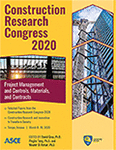Construction Research Congress 2020
Developing an Ontology for Implementation of Lean Construction Methods in Construction Projects
Publication: Construction Research Congress 2020: Project Management and Controls, Materials, and Contracts
ABSTRACT
Although lean methods have been used on construction projects for over three decades, the adoption of such methods into the project delivery process varies in formal planning and implementation. This makes it challenging to benchmark the performance of projects implementing lean construction methods. Preliminary analysis of literature combined with a content analysis of expert interviews with lean practitioners suggested that there is an opportunity to improve the awareness, understanding, and education of lean methods. As a result, the adoption of lean methods would also improve. However, to improve the awareness, understanding, and education of lean methods, there is also the need to develop consistent terminology that can be used. Having identified this need, further investigation of various knowledge representation techniques resulted in the identification of domain ontologies as a mechanism to organize the domain of lean construction methods. This paper presents the summary of the various approaches and tasks adopted from ontological methodologies to outline the process for developing the lean construction methods ontology and the ontology structure. The paper concludes with future research directions focused on documentation of the knowledge within the ontology, ontology evaluation using expert interviews, and ontology application using project case studies.
Get full access to this article
View all available purchase options and get full access to this chapter.
REFERENCES
Abdelhamid, T. and Salem, S. (2005). “Lean Construction: A New Paradigm for Managing Construction Projects.” International Workshop in Materials and Design of Civil Infrastructure. 28-29 December, Cairo, Egypt.
Aziz, R. F., & Hafez, S. M. (2013). “Applying lean thinking in construction and performance improvement.” Alexandria Engineering Journal, 52, 679–695.
Alarcón, L. F., Diethelm, S., Rojo, O., & Calderón, R. (2008). “Assessing the impacts of implementing lean construction.” Revista Ingenieria de Construcción, 23(1), 26–33.
Arroyo, P. (2014). “Exploring Decision-Making Methods for Sustainable Design in Commercial Buildings.” Doctoral Dissertation, University of California, Berkeley, U.S.A.
Ballard, H. G. (2000). “The Last Planner System of Production Control”. PhD Thesis, School of Civil Engineering, University of Burmingham, Burmingham, UK.
Bodenreider, O., & Stevens, R. (2006). “Bio-ontologies: Current trends and future directions.” Briefings in Bioinformatics, 7(3), 256–274.
Cano, S., Delgado, J., Botero, L., & Rubiano, O. (2015). “Barriers and Success Factors in Lean Construction Implementation Survey in Pilot Context.” Proc., 23rd Annual Conference of the International Group for Lean Construction, Perth, Australia, 631–641.
El-Gohary, N. M., & El-Diraby, T. E. (2010). “Domain Ontology for Processes in Infrastructure and Construction.” J. Constr. Eng. Manage., 136(7), 730-744.
McGraw Hill Construction Research & Analytics. (2013). “Lean Construction. Leveraging Collaboration and Advanced Practices to Increase Project Efficiency.” Smart Market Report, McGraw Hill Construction, Bedford, MA.
Gambatese, J. A., Asce, M., Pestana, C., & Lee, H. W. (2017). “Alignment between Lean Principles and Practices and Worker Safety Behavior.” J. Constr. Eng. Manage., 143(1): 04016083-1-10.
Gómez-Pérez, A., Fernandez-Lopez, M., Corcho, O. (2004). “Ontological Engineering with Examples from the Areas of Knowledge Management, E-Commerce and the Semantic Web.” 2nd Printing, Springer-Verlag London Limited, ISBN: 1-85233-551-3.
Lenat, Douglas B.; Guha, R. V. (1989). “Building Large Knowledge-Based Systems; Representation and Inference in the Cyc Project”, 1st Edition, Addison-Wesley Longman Publishing Co., Inc., Boston, MA, USA. ISBN 0201517523.
Lichtig, W. (2005). “Sutter Health: Developing a Contracting Model to Support Lean Project Delivery”. Lean Construction Journal, 2(1), 105-112.
Liu, L., & Eds, M. T. Ö. (2008). “Ontology.” In Encyclopedia of Database Systems.
Marhani, M. A., Ahmad Bari, N. A., Ahmad, K., Jaapar, A. (2018). “The Implementation of Lean Construction Tools: Findings from a Qualitative Study, Chemical Engineering Transactions.” 63, 295-300.
Neto, J. de, P.B., & Alves, T. da C. L. (2007). “Strategic Issues in Lean Construction Implementation.” Proc., 15th Annual Conference of the International Group for Lean Construction, 78–87.
Nofera, W., Abdelhamid, T., and Lahouti, A. (2015). “Teaching Lean Construction for University Students.” Lean Construction Journal, 34-44.
Rybkowski, Z. K. (2009). “The Application of Root Cause Analysis and Target Value Design to Evidence-based Design in the Capital Planning of Healthcare Facilities.” Doctoral Dissertation, University of California, Berkeley, CA.
Salem, O., Solomon, J., Genaidy, A., & Luegring, M. (2005). “Site Implementation and Assessment of Lean Construction Techniques.” Lean Construction Journal, 2(2), 1–21.
Sarhan, S. & Fox, A. (2013). “Barriers to Implementing Lean Construction in the UK Construction Industry.” The Built & Human Environment Review, 6, 1-17.
The Lean Construction Institute. (2017). LCI Lean Project Delivery Glossary. Downloaded on 9.7.2018 from: https://www.leanconstruction.org/media/docs/LCI_Glossary.pdf
Tsao, C. C. Y., Alves, T.C.L., Mitropoulos, P.T. (2012). “Different Perspectives on Teaching.” Proc., The 20th Annual Conference of the International Group for Lean Construction, San Diego, CA, USA.
Uschold, Michael & Grüninger, Michael. (1996). “Ontologies: Principles, methods and applications.” The Knowledge Engineering Review, 11(2), 93-136.
Information & Authors
Information
Published In
Construction Research Congress 2020: Project Management and Controls, Materials, and Contracts
Pages: 427 - 435
Editors: David Grau, Ph.D., Arizona State University, Pingbo Tang, Ph.D., Arizona State University, and Mounir El Asmar, Ph.D., Arizona State University
ISBN (Online): 978-0-7844-8288-9
Copyright
© 2020 American Society of Civil Engineers.
History
Published online: Nov 9, 2020
Published in print: Nov 9, 2020
Authors
Metrics & Citations
Metrics
Citations
Download citation
If you have the appropriate software installed, you can download article citation data to the citation manager of your choice. Simply select your manager software from the list below and click Download.
